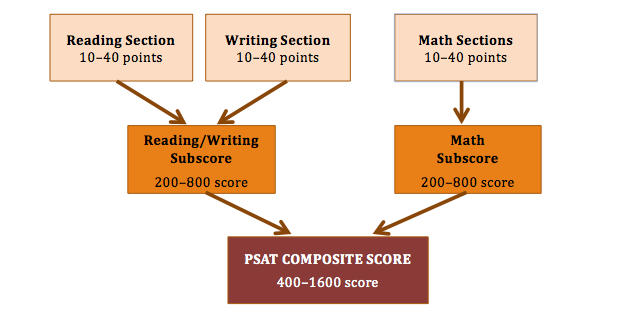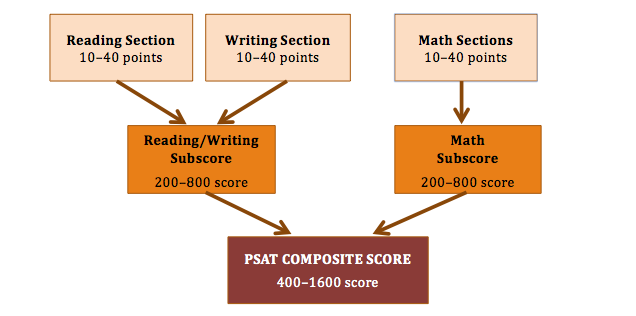Just like the SAT, the PSAT is changing. The College Board has announced that the PSAT—a test normally taken by juniors as practice for the SAT—will be reformatted to match the new SAT.
When will the new PSAT go into effect?
The first administration of the new PSAT will be October 2015. This means that the new exam will be used for the first time to determine National Merit winners for the Class of 2017.
How will it be scored?
Guessing Penalty: There will no longer be a guessing penalty on the exam, so guess on every question!
Total Score: The total or “composite score” for the new PSAT will range from 400 to 1600 points. It will be the sum of two subscores: one from the Reading/Writings sections combined and one from the Math Sections. See diagram below. The new PSAT scoring system will be EXACTLY the same as the new SAT scoring system, so it will be easier to predict your SAT score from your PSAT performance. The new PSAT will also provide subscores for various skills in each section, which show a student where to study in order to improve.
What’s new in Math?
Format: 2 sections
Calculator Section
- Questions: 27 multiple-choice, 6 grid-ins
- Time: 45 minutes
No Calculator Section
- Questions: 13 multiple-choice, 4 grid-ins
- Time: 25 minutes
Calculator Use: There will be one section that students can use the calculator for and one section without a calculator.
Real-World Situations: Many of the new Math questions will ask student to apply mathematical reasoning to situations in business, science, or the social sciences.
Multi-Step Grid-In: In the calculator section, there will be a word problem with multiple parts. It will ask students to answer at least two grid-in questions related to a real-world situation. These questions will be worth slightly more points than the others on the exam.
Less Geometry: Because the new PSAT will more heavily focus on algebra and data analysis, there will be less geometry.
What’s new in Reading?
Format: 4 long passages, 1 double passage
Questions: 47 multiple-choice
Time: 60 minutes
Vocabulary: Sentence Completions have been eliminated on the test. Instead, the new PSAT will contain 10 questions that test vocabulary within the context of the passages. Also, gone are the obscure PSAT words. The new PSAT will test vocabulary students see in college and in their future careers.
Graphics: Passages will now include charts, graphs, or pictures related to the text. For example, a student might be asked how the author of the passage needs to change the passage’s argument to better reflect the data in a chart.
Evidence-Based: Some of the Reading questions will ask students to read more deeply. Instead of just answering a question about the author’s tone, a student will need to find the specific lines in the passage that provide evidence of the author’s tone.
What’s new in Writing?
Format: 4 passages to correct
Questions: 44 multiple-choice
Time: 35 minutes
Passage-Based: Most of the Writing questions on the current PSAT force students to correct the grammar of stand-alone sentences without any context. The new PSAT will provide full passages for students to edit.
Vocabulary: The new PSAT will contain 8 vocabulary questions in this section. These questions will ask students to pick the best words to capture the author’s tone or argument in the text.
Graphics: At least one of the passages will include a graph, picture, or table related to the text. Students will need to answer a question that tests how well they understand the relationship between the graphic and the passage. For example, a question might ask a student to edit a line in the text that misrepresents the data from a pie chart.
Any other important changes?
Length: The new PSAT will be 30 minutes longer than the current PSAT. In total, the new PSAT will be 2 hours and 45 minutes long.
Fewer Answer Choices: Instead of 5 answer choices per multiple-choice question, new PSAT questions will only have 4 answer choices. That’s good news: students will have a better chance of guessing correctly with fewer answers to pick from.
What’s not changing?
No Essay: Just like the old PSAT, the new exam will NOT contain an essay.
National Merit: For decades, the PSAT has been the qualifying exam for the National Merit Scholarship Competition. The new PSAT will still be the qualifying exam for National Merit starting for those students graduating in 2017.







